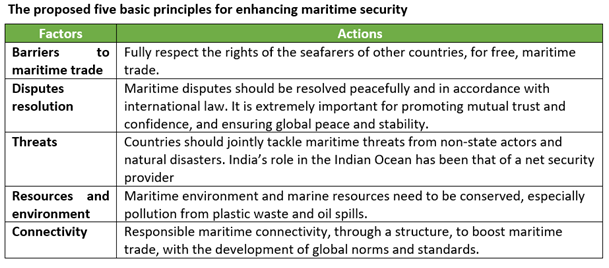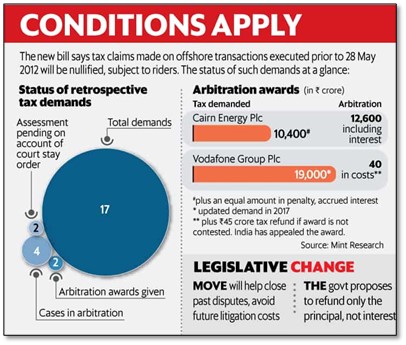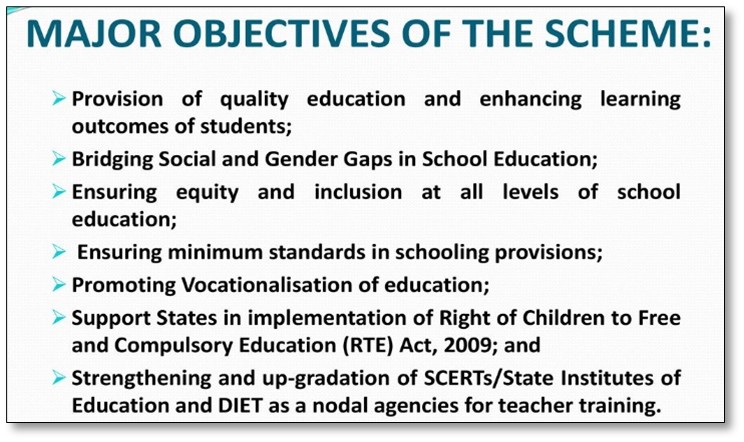Friday, 9th July 2021
OECD-FAO Agricultural Outlook 2021-2030
In News
The Agricultural Outlook 2021-2030 report has been recently released by the Organization for Economic Co-operation and Development and the UN Food and Agriculture Organization (FAO).
About the News
- The OECD-FAO Agricultural Outlook 2021-2030 provides a consensus assessment of the ten-year prospects for agricultural commodity and fish markets at national, regional, and global levels, and serves as a reference for forward looking policy analysis and planning.
- It highlights fundamental economic and social trends driving the global agri-food sector assuming no major changes to weather conditions or policies. Since this year’s Outlook period ends in 2030, the report’s projections also suggest areas where more attention is needed to achieve the Sustainable Development Goals (SDGs)
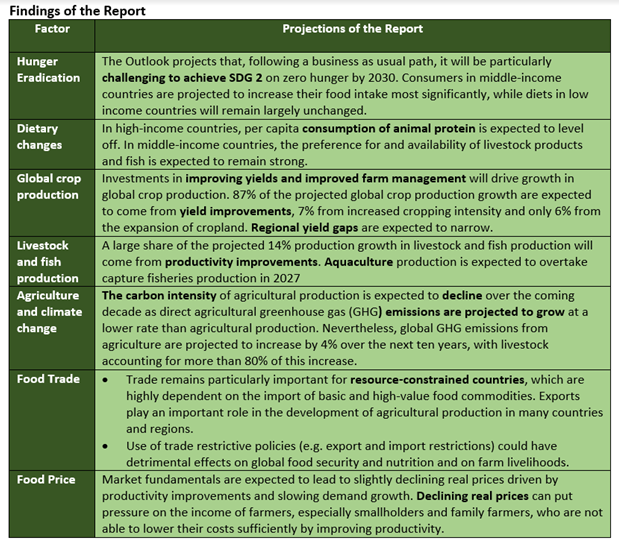
Review of Global Counter Terrorism Strategy (GCTS)
In News
The seventh Review of Global Counter Terrorism Strategy took place in June 2021.
The GCTS
- The GCTS is a unique global instrument to enhance national, regional and international efforts to counter terrorism. Through its adoption by consensus in 2006, all UN Member States agreed the first time to a common strategic and operational approach to fighting terrorism.
- The UN General Assembly reviews the Strategy every two years, making it a living document attuned to member states’ counter-terrorism priorities.
Pillars of the GCTS
- Addressing the conditions conducive to the spread of terrorism
- Measures to prevent and combat terrorism
- Measures to build states’ capacity to prevent and combat terrorism and to strengthen the role of the United Nations system in that regard
- Measures to ensure respect for human rights for all and the rule of law as the fundamental basis for the fight against terrorism
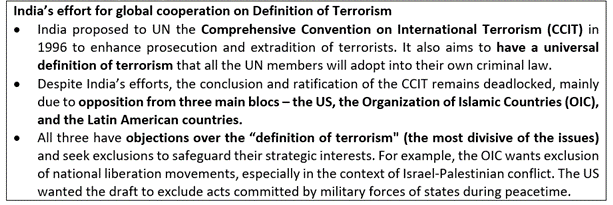
Issues raised by India at the Seventh Review of GCTS
- India noted that the continued absence of a universally agreed definition of terrorism is “detrimental to our shared goal” of eliminating the global scourge of terrorism. The current strategy fails to resolve the stalemate preventing the adoption of a comprehensive convention on international terrorism, which India has championed.
- There are attempts to divide the world by adopting new terminologies under the guise of “emerging threats” such as racially and ethnically-motivated violent extremism, violent nationalism, right wing extremism, etc.
- India noted that while the matter of religious “phobias” finds mention in the current document, this listing has been selective. India emphasized to acknowledge the rise of hatred and violent terrorist attacks against other religions, inter alia, Buddhism, Sikhism and Hinduism.
- India also argued that the misuse of internet and social media for terrorist propaganda, radicalisation, and recruitment of cadre; misuse of new payment methods such as block-chain currencies, payment wallets, crowdfunding platforms for terrorism financing; and misuse of emerging technologies such as drones, 3D printing, Artificial Intelligence, robotics have emerged as the most serious threats of terrorism, which warrants collaborative actions from all member states.
https://www.pminewyork.gov.in/IndiaatUNGA?id=NDMwMA
https://www.un.org/counterterrorism/un-global-counter-terrorism-strategy
Water wars of Andhra Pradesh and Telangana
In News: An ongoing jala jagadam (fight over water resources), has drawn the police forces of Andhra Pradesh and Telangana into a tense standoff at the common reservoirs of the two states.
Interstate River Water Dispute
- India has 25 major river basins, with most rivers flowing across states.
- As river basins are shared resources, a coordinated approach between the states, with adequate involvement of the Centre, is necessary for the preservation, equitable distribution and sustainable utilization of river water.
- The Interstate River Water Disputes Act, 1956 (IRWD Act) was enacted under Article 262 of the Constitution of India to resolve water disputes that would arise in the use, control and distribution of an interstate river or river valley.
- Article 262 of the Indian Constitution provides a role for the Central government in adjudicating conflicts surrounding inter-state rivers that arise among the state/regional governments.
Krishna River Dispute
- Andhra Pradesh and Telangana have been having disagreements over the sharing of the Krishna River which continues to shape politics in the region.
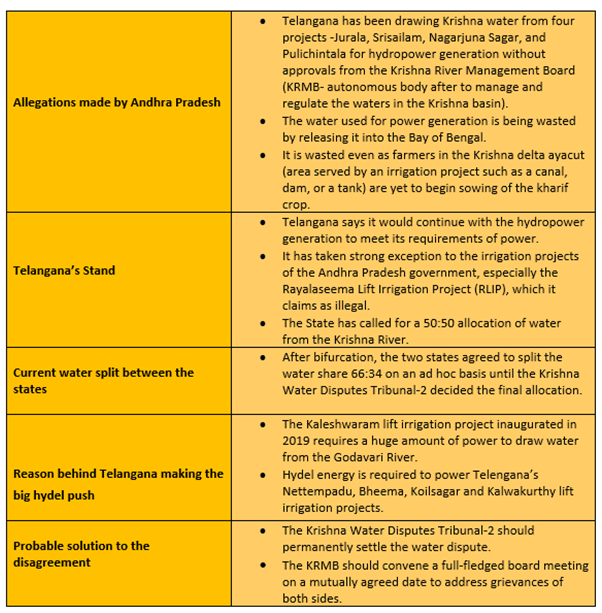
https://www.orfonline.org/research/federalism-and-interstate-river-water-governance-in-india/
Picture source: https://sandrp.in/2016/10/06/inter-state-river-water-disputes-in-india-history-and-status/
Integrated Theatre Command
In News
A high-level committee consisting of representatives from the services and the Ministries concerned has been formed for wider consultations on the creation of integrated tri-service theatre commands.
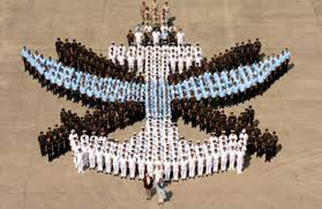
About the News
- For better coordination of the armed services, the Indian military is setting up five integrated theatre commands by 2023 with well-defined areas of operation. The Chief of Defence Staff is working on redesigning existing military commands into theatre commands that will combine the resources and assets of the three defence forces.
- This process gathered steam after the appointment of the first Chief of Defence Staff (CDS) and the creation of the Department of Military Affairs (DMA) in the Ministry of Defence. One of DMA’s roles is “facilitation of restructuring of Military Commands for optimal utilization of resources by bringing about jointness in operations, including through establishment of joint / theatre commands.”
What is Theaterisation?
- Theaterisation is a concept that seeks to integrate the capabilities of the three services -- army, air force and navy, and optimally utilise their resources for wars and operations. The idea behind ‘Theatre Command System’ is to bring synergistic coordination between the three branches of the armed forces.
- India’s first chief of defence staff (CDS) has been given the mandate to steer the theaterisation The theaterisation model will have the inbuilt flexibility to fall back on current command and control structures to eliminate the possibility of the country getting caught off guard by its adversaries during the crucial transition phase
What is the Proposed Structure for Integrated Theatre Command in India?
- Current structure: India currently has 19 military commands with 17 of them service-oriented. While both the Army and the Air Force have seven commands each, the Navy has three. India also has a Tri-Service Command — Andaman and Nicobar Command — besides the Strategic Forces Command (SFC), which looks after the country’s nuclear stockpile.
- Proposed Structure: According to the current proposal, there will be five theatres — Northern Land Theatre (Jammu and Kashmir, Ladakh and Central sector) Western Land Theatre (Pakistan centric), Eastern Land Theatre, Maritime Theatre Command, and Air Defence
- There will also be a Logistics Command, which will have the logistics of all the Services under one person; and there will be a Training and Doctrine Command, so that all Services work under a common doctrine and have some basic common training.
- The Indian Army’s Northern Command is the only single-service command that will stay outside the scope of the military’s theaterisation drive. It is responsible for guarding the country’s borders with Pakistan and China in the north, and is the nerve centre of counterterrorism operations in Jammu & Kashmir.
- The first phase involves the creation of Air Defence Command and Maritime Theatre Command.
- Air Defence Command: The Air Defence Command will spearhead the country’s aerial attack and be responsible for defending Indian airspace through multi-role fighters with all anti-aircraft missiles under its control. This will control air defence resources of all three services. It will be headed by a top three-star Indian Air Force officer based in Prayagraj.
- Maritime Command: It will be tasked to protect the Indian Ocean and India’s island territories as well as keep the sea lanes free and open from any outside pressure. It will be headed by a top three-star Indian Navy officer and will be based in Karwar, Karnataka. It could also include the tri-service Andaman and Nicobar Islands Command.
Why do we need Theaterisation of the military?
- Operational Synergy: The 1999 Kargil conflict heightened the appreciation that modern wars require huge synergy. The integration process would ultimately lead towards the unified military assets fused into one single command under one operational head who will be responsible for directing and controlling their activities in a given situation.
- Economic Benefits: The theatre command system will also contribute to more streamlined costs and a leaner fighting force. As the outlays of the annual defence budget do not always grow in line with the actual needs of the armed forces, the theatre command system help reduce redundancies through systematic planning and redirecting a sizeable portion toward maintenance and modernization of equipment and capabilities. Also, the Joint Logistics Command would look at common contract management for the three services and be responsible for common inventories for maintaining reserves.
- Meeting Global Standards: Most leading militaries, including those of the United States, Russia, China, United Kingdom and France, function as per the theatre command concept. The US military, the world’s most powerful, has 11 combatant commands. Similarly, the Chinese People’s Liberation Army has five theatre commands, with its western theatre handling the entire border with India. Pakistan has sought Beijing’s help to reorganise its forces under the same military concept.’
Challenges
- Timing of Theaterisation: India currently faces a 'Two Front Threat', a standoff with the largest military in the world, and the other adversary through new methods like drones/terror attacks. Strategically, it is may not be the right time to go through such a major apex level restructuring, as it may bring turbulence in time tested command structure and compromise operational effectiveness of Indian Military during the intervening period.
- Inadequate Capability: The Maritime Command accruing advantage of unity of command, will have to be weighed against manageability of increased span of control, as Indian definition of Indo-Pacific and area of maritime interest has grown from eastern coasts of Africa to northern Pacific, up to Japan. The current personnel and staff have not been tasked and organised for it. So, capability development of Apex level needs to be worked out.
- Integration of Current systems: Problems will arise in integrating the establishments like the Border Roads Organisation and the Indian Coast Guard, both managed presently by the MoD and Central paramilitary forces like the Border Security Force, Assam Rifles and the Indo-Tibetan Border Police, that are run by the Ministry of Home Affairs.
- Parity in status and seniority: Parity in status and seniority of military officers with regard to their civilian counterparts can be an issue. Major challenges would be the structure of command, i.e. who will report to who within the tri-services and joint theatre command configurations, and who will have operational command over personnel and machinery, service chiefs or theatre commanders.
- Concerns of the Indian Air Force: The Indian Air Force is an offensive component of Indian Military. It has national role besides synergising with other services to contribute to National Combat Power. For comprehensive air battle, with inadequate air resources, switching assets between operational commands of same service is much more effective than trying to do so between integrated theatre commands with dedicated resources. Multi-Domain Operations is an art and technology not yet known to India and it forms the basis of Theatre Commands.
Conclusion
The formation of integrated theatre commands has been hailed as the next logical step in the process of defence reforms to synergise the capabilities and combat potential of the three Services during war and peace. One of the most vital changes that may come about with the adoption of integrated theatre commands, though, would be how the three arms of the Indian military operate with one another, not as individual services, but as the “armed forces of the union.” To achieve a more efficient command and control configuration, as is desired, it would be vital to ensure that bureaucracy is kept to a minimum.
Question: What is the need for theaterisation of military in India? Analyse the challenges in the process.
Primary Sources: https://indianexpress.com/article/explained/proposed-integrated-theatre-commands-what-we-know-so-far-7374555/
Secondary Sources: https://www.hindustantimes.com/india-news/northern-command-kept-out-of-theaterisation-ambit-101625162857686.html
This Day in History- John A Wheeler
On July 9, 1911, John Archibald Wheeler, an American physicist, was born. He originated a novel approach to the unified field theory and popularized the term black hole and helped invent the theory of nuclear fission. He was a young contemporary of Albert Einstein and Niels Bohr, was a driving force in the development of both the atomic and hydrogen bombs and, in later years, became the father of modern general relativity.

Sources: https://phy.princeton.edu/department/history/faculty-history/john-wheeler
https://www.britannica.com/biography/John-Archibald-Wheeler
https://www.nytimes.com/2008/04/14/science/14wheeler.html
Image of the Day -Dead Mussels
This is the image of dead mussels at the waterline in British Columbia. More than 1 billion marine animals along Canada’s Pacific coast are likely to have died from last week’s record heatwave, experts warn, highlighting the vulnerability of ecosystems unaccustomed to extreme temperatures. The “heat dome” that settled over western Canada and the north-western US for five days pushed temperatures in communities along the coast to 40 degree C. Mussels are hardy shellfish, tolerating temperatures into the high 30 degree Celsius. The mass death of shellfish would temporarily affect water quality because mussels and clams help filter the sea, keeping it clear enough that sunlight reaches the eelgrass beds while also creating habitats for other species.
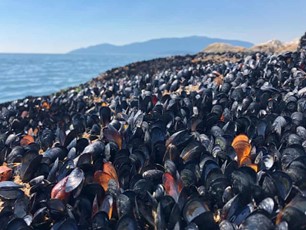
Source: https://www.theguardian.com/environment/2021/jul/08/heat-dome-canada-pacific-northwest-animal-deaths
Department of Public Enterprises (DPE) merges with Finance Ministry
- Context: The finance ministry has been expanded with the addition of Department of Public Enterprises (DPE), which was part of the Ministry of Heavy Industries and Public Enterprises.
- The merger will give it a better control over key state-owned firms, review their capital expenditure plans and chalk out measures relating to revival as well as closure of CPSEs.
- DPE will be responsible for annual survey of public enterprises; residual work relating to erstwhile Bureau of Public Enterprises including industrial management pool; coordination, evaluation and monitoring the performance and capital expenditure of PSEs, categorization of CPSEs including conferring Ratna Status.
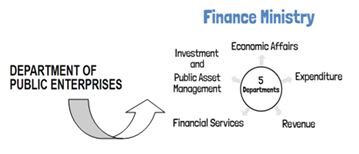
Primary source: https://www.livemint.com/news/india/finance-ministry-expansion-department-of-public-enterprises-added-11625637588779.html
Picture source: https://wn.com/ministry_of_finance/news
India-EU Meet of Agriculture
- Context: The virtual meeting between India’s Union Minister for Agriculture & Farmers Welfareand the Member of the European Commission (EC), Agriculture was held recently.
- In the meeting, the recent reforms undertaken by the EU in the Common Agriculture Policy as well as the EU Farm to Fork Strategy to make agriculture green as well as sustainable were discussed. EU’s target of bringing 25 per cent of area in the EU under Organic Farming by 2030 was also mentioned.
- The association will also help the scenario of agriculture in India which has dominance of small farmers. The Government’s commitment towards farmers’ welfare, the recent initiatives to increase the incomes of the farmers, the launch of Agriculture Infrastructure Fund for development agriculture marketing infrastructure in rural areas, scheme of formation of 10000 FPOs etc. will receive a thrust through this meeting.
- The steps being taken by the government to make agriculture sustainable and environment friendly include encouragement of application nano-urea and organic farming under the Pramparagat Krishi Vikas Yojana.
- The issue of fixing the Maximum Residual Limit (MRL) of Tricyclazole used in rice crop which has been a concern for India which is affecting India’s Basmati Rice Exports to the EU has also been raised.
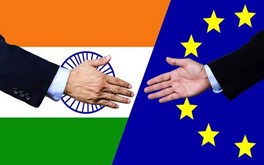
Primary source: https://www.pib.gov.in/PressReleasePage.aspx?PRID=1733482
Picture source: https://www.thehindubusinessline.com/economy/focus-areas-for-india-eu-leaders-summit-in-may/article33781984.ece
Pegasus
- Context: An online database about the use of the spyware Pegasus was recently launched by the Forensic Architecture, Amnesty International and the Citizen Lab.
- Pegasus is a spyware tool from Israeli firm NSO Group.
- Pegasus works by sending an exploit link, and if the target user clicks on the link, the malware or the code that allows the surveillance is installed on the user’s phone.
- A presumably newer version of the malware does not even require a target user to click a link.
- Once Pegasus is installed, the attacker has complete access to the target user’s phone.
Primary source: https://www.thehindu.com/news/national/new-online-platform-maps-pegasus-spread/article35185350.ece
Human papillomavirus (HPV) Testing
- Context: WHO has allowed self-collected samples of HPV testing.
- HPV testing detects the genetic material (DNA or messenger RNA) of high-risk HPV, primarily to screen for cervical cancer or to determine whether one is at risk of cervical cancer.
- Human papillomavirus is the most common viral infection of the reproductive tract.
- A sample of cells is taken from the cervical area during a pelvic exam and is placed into a bottle containing a special liquid preservative which then can be used for the HPV test.
- Many HPV infections resolve without treatment-the body is able to clear the infection.
- However, infections with high-risk HPV types that do not go away can lead to cervical cancer. Almost all cervical cancers are caused by persistent infections with high-risk HPV.

Primary source: https://labtestsonline.org/tests/human-papillomavirus-hpv-test
Picture source: https://www.medicalnewstoday.com/articles/246670
Time to end the battle of Indian pharmaceutical players and Chinese key ingredients-ORF
Essence: The Indian pharmaceutical industry is one of the major contributors to the Indian economy and it is the world’s third-largest industry, next only to China and Italy. As the Indian bulk drug industry has grown, it has progressively evolved to become a preferred source for premium active pharmaceutical ingredients (APIs) with high value. In spite of India being one of the top manufacturers of formulation drugs, India heavily relies on bulk drug imports (65 percent–70 percent of the APIs from China). Heavy dependence on one country may cause potential risk of price volatility and supply disruption (apparent due to COVID-19 pandemic). Beside this the pharmaceutical and bulk drug industries are regulated by multiple regulatory bodies, either directly or indirectly. To overcome this challenge, article suggested several steps should be taken along with Indian manufacturers should opt for building their own API production units
Why should you read this article?
- To get an overview of Indian pharmaceutical industry and what are the challenges they are facing?
- To understand the reasons for heavy dependence of India on China for APIs.
- To know what possible steps India should take to overcome these challenges.
Article Link: https://www.orfonline.org/expert-speak/time-to-end-the-battle-of-indian-pharmaceutical-players-and-chinese-key-ingredients/
India must show global leadership on climate crisis by adopting a holistic approach to energy- IE
Essence: Editorial is discussing the fault lines in our policy on climate crises, major challenges ahead & solutions. G7 countries are announcing “net zero carbon” targets, which hide the continued reliance on destructive technologies in the pursuit of ever-increasing energy generation. The historical responsibility of industrialised countries in creating the crisis continues to be avoided.
Rapid increase in renewable energy (RE) capacity and partnerships like the International Solar Alliance have won appreciation for India, but there are some flaws. India is also expanding fossil fuel extraction and use. In effect, total carbon emissions, which is what impacts climate, will keep going up even as RE’s share rises. A shift from petrol-diesel to electric cars, for instance, would significantly expand devastating mining across the world. This is also a consequence of thinking of climate and ecological crises only from a carbon perspective, ignoring biodiversity loss and pollution.
Why you should read this article?
- To know about the contradictions in our approach towards climate change.
- To understand the need to assess social & ecological impacts of mega renewable energy projects.
- To understand the gaps in promises & responsibilities over climate change issues.
Nearly 4,000 Odisha villages free of child marriage now
Background
- According to a UNICEF 2017 report, India had more than 15 lakh child brides in the world.
- Child marriages surged after COVID-19 first wave in Odisha but in the second wave nearly 4000 villages were declared child marriage-free
- This is drastic improvement within 1 year as only 62 villages were declared child marriage-free in 2020.
How did the state bring this change
- Verification: District child marriage verification teams covered the villages to check the high prone areas where this malpractice continued.
- Specific criteria district wise: Local specific criteria helped in making targeted intervention.
- Awareness: Locals were sensitised about the issue by child-marriage prohibition officer
- Grassroots involvement: Undertakings were submitted by village-level child-marriage prohibition committee on behalf of the villages to stop child marriage
- Bottom-up approach: The whole process was largely led by the community with bottom-up approach where villagers took decisions on their end.
Outcome
- Uphold various rights: Girl child can now enjoy Right to Education, Right to childhood and Leisure
- Reduces the risk of maternal mortality: Risk of maternal mortality is highest for adolescent girls in the 15 years of age which can be reduced if the child marriage is reduced.
- Gender Equality: Due to a child marriage, a child remains dependent and disempowered, which acts as a big hurdle towards achieving gender equality
- Education empowerment: Child Brides often have togive up their education due to household responsibilities.
Things To Ponder
It is said that if the women of a house are educated, she, in turn, educates her family. But if she is uneducated, she loses the opportunity to educate her own children.
Share the article
Get Latest Updates on Offers, Event dates, and free Mentorship sessions.

Get in touch with our Expert Academic Counsellors 👋
FAQs
UPSC Daily Current Affairs focuses on learning current events on a daily basis. An aspirant needs to study regular and updated information about current events, news, and relevant topics that are important for UPSC aspirants. It covers national and international affairs, government policies, socio-economic issues, science and technology advancements, and more.
UPSC Daily Current Affairs provides aspirants with a concise and comprehensive overview of the latest happenings and developments across various fields. It helps aspirants stay updated with current affairs and provides them with valuable insights and analysis, which are essential for answering questions in the UPSC examinations. It enhances their knowledge, analytical skills, and ability to connect current affairs with the UPSC syllabus.
UPSC Daily Current Affairs covers a wide range of topics, including politics, economics, science and technology, environment, social issues, governance, international relations, and more. It offers news summaries, in-depth analyses, editorials, opinion pieces, and relevant study materials. It also provides practice questions and quizzes to help aspirants test their understanding of current affairs.
Edukemy's UPSC Daily Current Affairs can be accessed through:
- UPSC Daily Current Affairs can be accessed through Current Affairs tab at the top of the Main Page of Edukemy.
- Edukemy Mobile app: The Daily Current Affairs can also be access through Edukemy Mobile App.
- Social media: Follow Edukemy’s official social media accounts or pages that provide UPSC Daily Current Affairs updates, including Facebook, Twitter, or Telegram channels.

